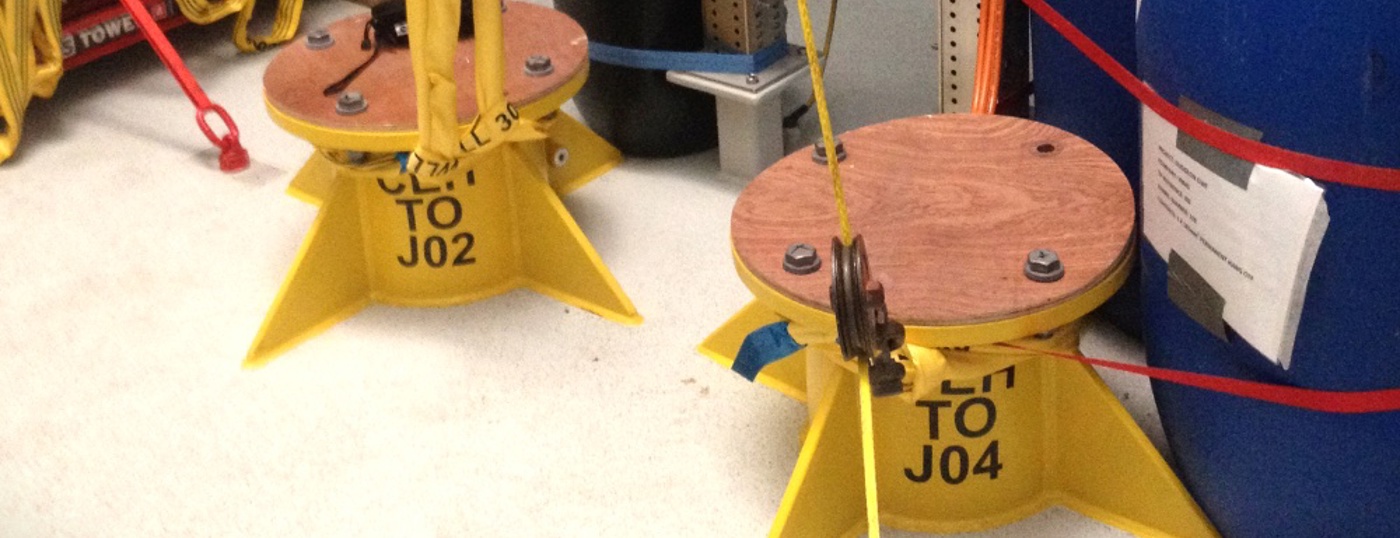The Dudgeon Offshore Wind Farm is located 32 kilometres off the coast of North Norfolk, United Kingdom. Since its completion in late 2017, it has produced clean, green energy through its 67 6MW wind turbine generators, enough to power 410,000 homes in the UK. Equinor, Masdar, and Statkraft jointly own the wind farm. Equinor serves as the operator, having developed the £1.4 billion power plant between 2012 and 2017.
In 2016, Boskalis Subsea Cables (formerly VBMS) contacted OceanTech. The Dudgeon project required assistance with installing sacrificial anodes to protect monopile transition pieces from corrosion. For this particular project, OceanTech’s* (Altrad Linjebygg’s) expertise in advanced rigging and lifting methods in the splash zone was decisive.
Decisive rigging and lifting capabilities
Sacrificial anodes protect transition pieces from corrosion caused by saltwater exposure. Made of a more active metal than the structures they protect, anodes corrode preferentially to transition pieces. As they corrode, they release electrons that neutralise the corrosion-causing ions in the surrounding environment. This slows the corrosion of the protected transition pieces to extend the service life of offshore wind farms’ support structures, reducing the need for costly repairs and maintenance.
Several challenges relate to anode installations at offshore wind farms, including accessibility, power supply, safety, and identifying the right rigging and lifting method:
- Transition pieces are located in the splash zone, which can be difficult to access and work in. The confined space makes the installation process challenging, especially if engineers need to weld or bolt the anodes.
- Some anodes require an external power supply to function, which can be tricky to provide in offshore environments.
- As with all splash zone operations, there are safety concerns. When installing anodes, it’s vital to consider the risk of falling, lifting injuries, and possible equipment failure.
- Lastly, anodes can be quite heavy, and installing them involves significant lifting. This can be challenging in environments with highly unpredictable weather conditions. The installation process can also be complex, as it involves various rigging and lifting equipment.
Each anode installed at the Dudgeon wind farm weighed approximately 200 kilograms, with previous attempts failing to lower them into the transition pieces. Additionally, the wind turbines lacked power as they had yet to be commissioned. When developing rigging and lifting methods for the Dudgeon project, the OceanTech engineering team focused on making it lightweight, safe, and flexible.
Planning is key to successful project execution
During autumn 2016, OceanTech’s leading expertise in developing custom rigging and lifting techniques contributed to a successful installation of 725 sacrificial anodes across 67 wind turbine generators at the Dudgeon Offshore Wind Farm. Given water depths from 18 to 25 metres, limited access, and the confined space inside the transition pieces, the specialist installation teams used 25,000 metres of Dyneema ropes to submerge the anodes.
Precision work at offshore wind farms requires careful planning, with a focus on safety, clear communication with all parties, and proper equipment. The rigging and lifting methods for the Dudgeon project underwent significant development and onshore testing in Vlissingen, Netherlands.
Our team tested the ropes to evaluate their load-bearing capacity, performance under simulated operational conditions, and abrasion resistance to wear and tear in harsh marine environments. Second, since no power supply was available at the wind farm, the specialist installation teams opted for electric hoists and mobile power units to load and unload equipment offshore.
Detailed planning and onshore testing ensure the safety of personnel and equipment, minimise environmental impacts, and optimise the operation’s efficiency. Ultimately, a project’s success relies heavily on collaboration and the various team’s expertise.
Our splash zone operations experts have a global track record that encompasses small cleaning projects to major multidisciplinary ventures. Our engineers and technicians possess a wide range of structural, mechanical, and electrical skills, offering design, calculation, and method planning support to clients. We continuously seek new and innovative approaches, ensuring that we remain the world’s top choice for splash zone solutions. In addition to anode installations, inspections, and replacements, we perform the following tasks for the offshore wind industry:
- Cleaning anchoring systems and turbine columns
- Monopile and jacket inspections and repairs
- Installing wrapping solutions, bumpers, and guides
- Boat landing systems repairs, retrofitting, or replacements
- Cutting and removing guides, brackets, and braces
Ensuring the reliability of the wind farm
Operation and maintenance activities typically represent 25–30% of total lifecycle costs for offshore wind farms. The anode installation at the Dudgeon Offshore Wind Farm has helped prevent internal galvanic corrosion inside the transition pieces, saving Equinor time and money in asset maintenance.
Corrosion can cause structural damage, leading to possible unplanned downtime, increased maintenance costs, safety hazards, and decreased energy production. Additionally, corrosion may cause environmental harm. Maintaining the integrity of the transition pieces ensures the longevity and reliability of the Dudgeon Offshore Wind Farm.
A key takeaway from this project is the importance of early involvement. Engaging skilled and experienced engineers during the design phase makes it possible to discover a cheaper, faster, and streamlined solution from the outset.
* OceanTech was established following a management buyout of the Splash Zone Division of Altrad Linjebygg in 2017.


